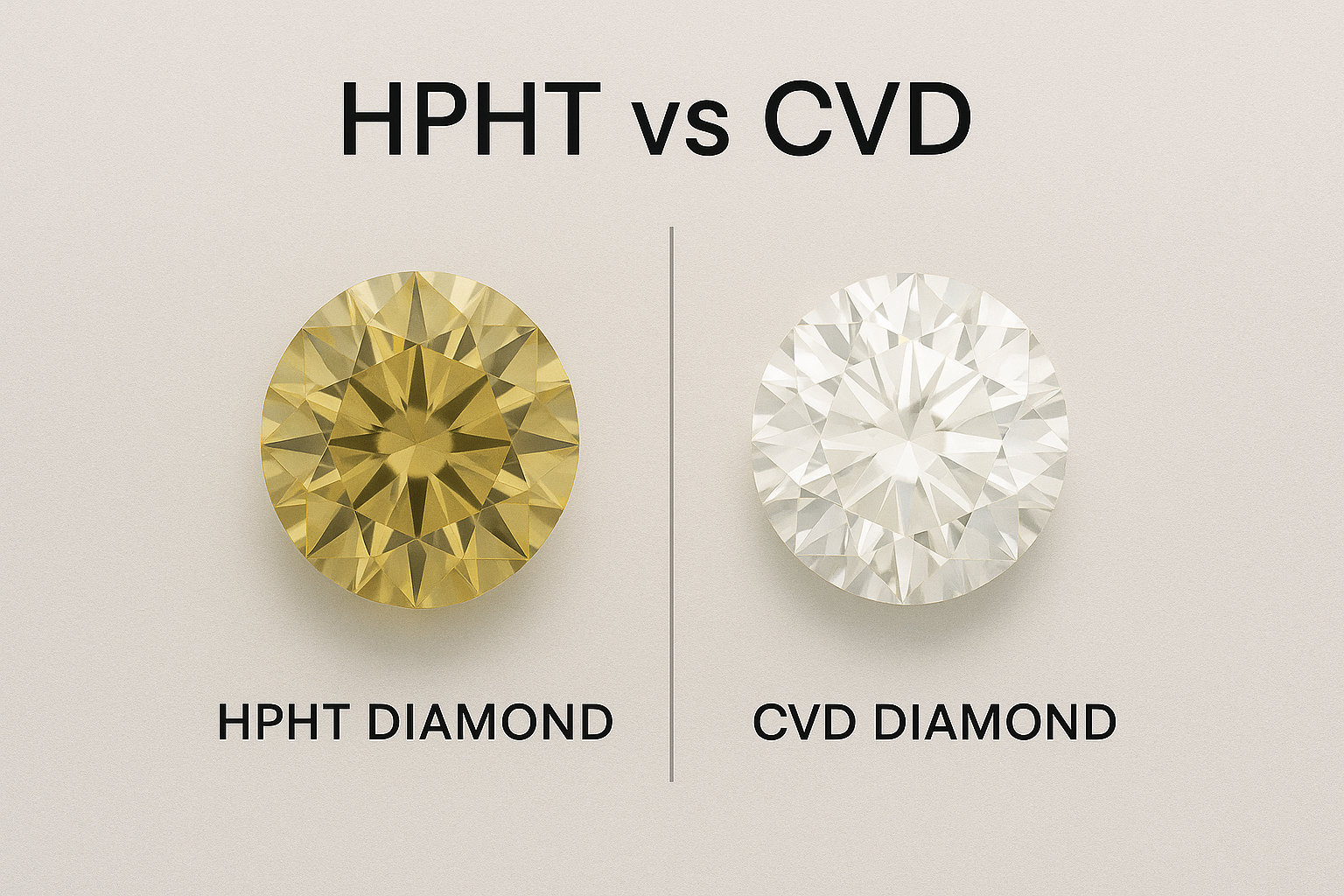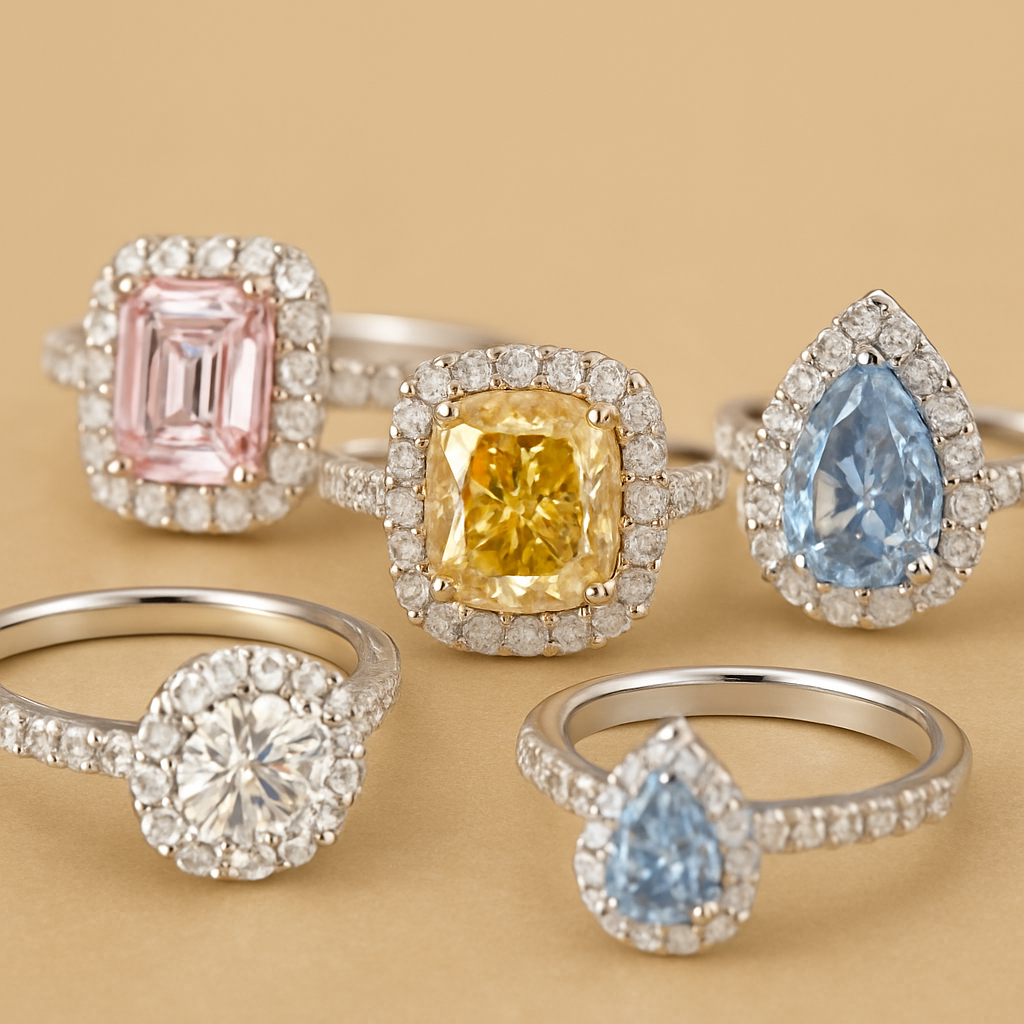Lab-grown diamonds have disrupted the fine jewelry market—providing an ethical, sustainable, and affordable option to mined diamonds. But did you know that lab-grown diamonds are not made using the same technique? In this blog, we'll explore the two most common types of lab-grown diamonds—HPHT and CVD, how they're different, and how to select the one that works for you.
Whether you are purchasing an engagement ring or making an investment in a classic San Liora piece, having this knowledge will enable you to make a wiser and more confident decision.
What Are Lab-Grown Diamonds?
Let's begin with the fundamentals. Lab diamonds are genuine diamonds, produced in a lab under controlled conditions through sophisticated technology that mimics nature's diamond-formation process. They possess the same physical, chemical, and optical characteristics as earth-mined diamonds and thus are nearly impossible to tell apart without expert examination.
Their uniqueness lies in where they come from—lab diamonds are produced with no environmental toll, no ethical issues, and no excessive expense of conventional diamond mining.
1. 🧪 HPHT Diamonds (High Pressure, High Temperature)

How They’re Made
HPHT is the acronym for High Pressure, High Temperature—a process that replicates the environment under which diamonds occur naturally within the Earth. A small diamond seed is inserted into a press where temperatures reach above 1,300°C and pressures reach higher than 1.5 million PSI. Carbon atoms adhere to the seed and crystallize into a complete diamond over several weeks or days.
Key Characteristics
- Due to metal inclusions (iron, nickel, and cobalt), they are frequently a little tinted (yellowish or brown).
- Under magnification, there might be metallic flux lines or inclusions visible.
- Additionally, HPHT can be utilized to intensify color, transforming brown diamonds into fancy-colored or colorless ones.
Ideal for
- diamonds with fancy colors (pink, yellow, and blue).
- industrial use because of its affordability and hardness.
Advantages:
- Economical production.
- Excellent for diamonds of various colors.
Drawbacks
- Metallic inclusions are more likely to be present.
- less clarity control than CVD.
2. 💡 CVD Diamonds (Chemical Vapor Deposition)

How They're Produced
A diamond seed is cultivated into a CVD diamond in a vacuum chamber that is filled with carbon-rich gas, typically methane. Similar to 3D printing a diamond, this gas is activated by heat or microwaves, which causes carbon atoms to deposit on the seed and gradually form layers.
Key Characteristics
- superior clarity and purity compared to HPHT diamonds.
- fewer additions.
- more likely to yield diamonds that are colorless or nearly colorless.
Ideal for
- Ideal for diamonds that are colorless or nearly colorless.
- center stones with high clarity in exquisite jewelry.
Advantages:
- Better control over clarity and color.
- Better for engagement rings and high-end jewelry.
Drawbacks
- Under specialized instruments, it might display growth patterns, or striation lines.
- A little more time was spent on production.
3. 🧬 Hybrid and Enhanced Lab Diamonds
Some diamond labs do the best of both worlds—CVD growth first, then HPHT treatment to enhance color or eliminate defects. These hybrid lab-grown diamonds are still considered lab diamonds and are usually impossible to tell from either procedure done separately.
Also, post-growth therapies such as annealing or irradiation may be utilized on both kinds to improve clarity or modify color. Such treatments are revealed on certificates and grading reports.
4. 💎 Are All Lab-Grown Diamonds the Same?
Not at all. Although all lab-created diamonds are technically real diamonds, the manufacturing process affects a number of factors:
- Clarity: CVD has fewer inclusions.
- Color: HPHT usually needs to be enhanced for colorlessness.
- Price: HPHT can be cheaper, particularly for colored diamonds.
Just as with mined diamonds, every lab diamond must be assessed based on the 4Cs: Cut, Color, Clarity, and Carat Weight. Also, inquire from your jeweler about the growth process of the diamond and verify the grading certificate from established labs such as IGI or GIA.
5. 🔍 Can You Tell the Difference?
Not to the on his own eye. The only way to differentiate between HPHT and CVD diamonds is with sophisticated gemological equipment. Purchasing from a reliable vendor, such as San Liora, is crucial because each lab-grown diamond is ethically sourced, openly graded, and accompanied by an appraisal certificate.
Frequently, the certificate will say:
- Growth technique (CVD or HPHT)
- If a post-growth treatment was used
- Complete information about light performance and the 4Cs
6. 🌱 Why It Matters – Ethics and Environment
Today's consumers are more aware than ever. Regardless of growth type, selecting lab-grown diamonds supports:
- There is no habitat loss, child labor, or earth displacement as a result of mining.
- Reduced carbon footprint: Particularly with more recent labs that run on renewable energy.
- More value: Better quality at a lower cost.
You're not just selecting sparkle when you go with San Liora's lab-grown diamonds; you're also choosing sustainability and responsibility.
7. 📝 Final Buying Tips
- Choose CVD if color and clarity are important to you.
- HPHT might be your best option if you're looking for a fancy, vivid color.
- Always request IGI or GIA certification.
- Purchase from a reliable vendor who reveals the diamond's provenance and care.
Our carefully chosen selection of certified lab-grown diamonds at San Liora, chosen for their brilliance, morality, and beauty.
Conclusion
Lab-grown diamonds provide the same sparkle and beauty as earth-mined diamonds—with benefits of transparency, ethics, and price. By learning about the distinctions between HPHT and CVD, you can choose a diamond that fits your values and style.
💎 Discover our luxury selection of certified lab-grown diamonds at SanLiora.com — where sustainability and sparkle entwine.







